
Amputation Page Menu: 1 2 3 4 5 6 7 8 9 10 11 12 First<<
Amputation During the Golden Age of Piracy, Page 12
Prosthetics and the Pirates
The crew finding [pirate captain Thomas Tew] expected their resolution, cried one, and all, "A gold chain or a wooden leg — I'll stand by you." (Captain Charles Johnson, The History of the Pirates, 1834 Edition, p. 76)
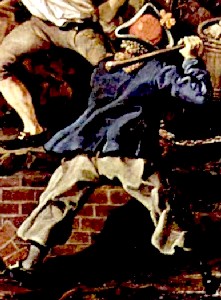
A peg-legged sailor from William Hogarth's
"Chairing the Member" (1755)
Where would the stereotypical pirate be without his wooden leg? (He'd be falling over.) Following a leg amputation, the patient would best be fitted with a prosthetic unless he wanted to spend the remainder of their life on crutches.
A second pirate prothetic which is considered to be standard today is the hand hook. Curiously, I haven't found any examples of a pirate from the golden age of piracy with a hook fitted to the end of his amputated arm. The closest example is privateer Christopher Newport, who sailed with Sir Francis Drake. (Thanks to peglegstick, a poster at pyracy.com for making me aware of him.) "After leading his men aboard an enemy ship off the coast of Cuba, his right arm was 'strooken off', and Newport was referred to thereafter as, 'Christopher Newport of the one hand.'"1 According to the Jamestown blog. " He had a hook for a right arm after that incident."2 Other sources suggest he may not have actually had a hook at all, but some other form of prosthetic.3 Whatever the case, Newport is reported to be the inspiritation for J.M. Barrie's Captain Hook from Peter Pan.4 Hook, in turn, is most likely the character who inspires the use of hooks in popular movies and cheap pirate costumes. Still, there is no period evidence for this. This isn't to say there were no pirates with hooks in place of their hands, just that there are no recorded examples of them.
1 "Captain Christopher Newport", gathered from captainchristophernewport.com, 5/3/2012; 2 "Captain Christopher Newport (1561-1617)", gathered from jamestowncolony1609.blogspot, 5/2/2012; 3 Kerry Dohouty, "University's Statue Has History Buffs Up in Arms", The Virginian-Pilot, originally printed July 19, 2007, gathered from the Internet 5/3/2012 4 Rachel McGinnis, "The Real Life and Fictional Characters Who Inspired J. M. Barrie's Captain Hook", gathered from Universitat De Velencia, 5/3/2012
Prosthetics and the Surgeon
"When the Chirurgeon has been forc'd to cut off a Leg or an Arm to save the Life of a wounded Patient, although he be perfectly cured, he is yet unable to go, by the loss of the Part which was necessary to the Performance of that function: 'tis not then enough for a Chirurgeon to have drawn him out of the Grave, he must by his Industry add an Organ in composition and use like the former." (Pierre Dionis, A course of chirurgical operations: demonstrated in the royal garden at Paris. 2nd ed., p. 416)

Artifical Legs vividly drawn - from Les
Oeuvres de M. Ambroise Paré (1575)
Following a leg operation, the patient either needed crutches or a prosthetic to get around. British naval medicine historian John Keevil gives us some insight into the operation as performed at the Savoy Hospital in London - a hospital for the poor and needy. "When [the amputee] got up, he was supplied with long crutches, locally made, and later with an iron or wooden leg fitted with straps, while exercising on this he used short crutches."1 Crutches would probably be a bit unwieldy on a ship, but they might well have been used until a proper prosthetic leg could be made.
As important as a prosthetic must have been to a successful amputation, only the two French surgeons I studied have anything to say about the practical aspects of designing and creating them: Pierre Dionis and Ambroise Paré. Dionis explains that there are "two Advantages from this Addition, the first is ornamental, as when we fix in an artificial Eye or Tooth; the second, is for Necessity, as when we add a wooden Arm or Leg; and 'tis particularly this last Species of Prosthesis which is necessary, since without its help the Man can't act."2 Paré concurs, noting that that the prosthetic is "not onely profitable for the necessitie of the bodie, but also for the decencie and comliness thereof."3
Both Paré and Dionis focus on the design of articifical legs, probably because they were more necessary to effective functioning than artificial arms and hands. Dionis explains that, "Every one knows how
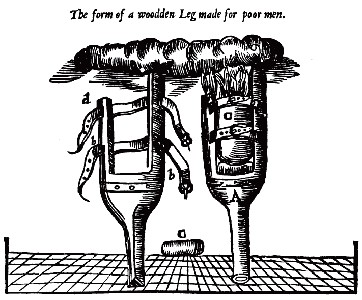
"The form of a woodden Leg made for poor men." From "The Workes of
that Famous Chirurgion Ambrose Parey. p. 588 (1649)
a wooden Leg ought to be made".4 He goes on to say that when creating a prosthetic leg the "its upper part is to be hollow, to comprehend the lower part of the Thigh; that it must have Ribbons or Tapes to tie and fasten it to the Thigh; that it must be provided with a small Cushion at the Place where the Knee lies, that the Part may not be hurt by the Hardness of the Wood, which is not to be brittle, but firm and strong for the Security of the Wearer."5
Paré does Dionis one better, giving the reader a lettered picture for reference with his quite explicit description of the prosthetic:
"A. Sheweth the stump or stock of the woodden Leg. BB. Sheweth the two staies which must bee on both sides of the Leg, the shorter of them must bee on the inner Side. CC. Sheweth the pillow or bolster, whereon the knee must rest in the bottom between the two staies, that so it may rest the softer. DD. Sheweth the thongs or girths with their round buckles, put through the two staies on either side to stay the knee in his place firm and immovable, that is slip not aside. E. Sheweth the thigh it self, that you may know after what fashion it must stand."6 You will notice in the figure that Paré calls this the limb 'for poor men,' which rather aptly describes most period sailors.
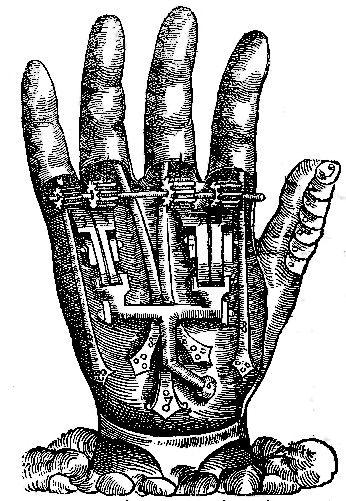
A rather complex mechanism for a prosthetic hand- from "Les
Oeuvres de M. Ambroise Paré," p. 916 (1575)
So who makes the artificial limb? Certainly the ship's carpenter could do the job, although he would be limited to the tools and materials he had on hand. Paré and Dionis suggest other professionals, although they were both writing as land-based surgeons with access to more resources. Paré suggests a blacksmith while Dionis calls for a "Carver".
Dionis recommends having two prosthetic legs, explaining "we are to cause one to be cut by the Carver, of the same Figure with the other, observing the Dimensions exactly; on this we put a Shoe and Stocking as on the other, and if it reaches up the Thigh, the Knee being cut, we may make it bend when we sit, by taking away one Ring or Ferrel, and putting it in again, when we would go."7 The description of such extravagance suggests to me that he is probably not talking about a wooden or peg-leg prosthetic, but one for a client of greater means than the average sailor.
Various editions of Paré's different texts show examples of some interestingly complex prosthetics. He explains that he has "caussed them to bee portraied, or set down, that those that stand in need of such things, after the example of them, may caus som Smith, or such like work-man to serv them in the like case."8 Most of these artifical limbs would be well beyond the means of the average sailor and certainly well beyond the means of most ships to create, but they are sort of fun to look at. Given how heavy such armor-like prosthetics must have been, it might have actually been preferable to be stuck with the wooden peg leg and hook!
 Full prosthetic arm - from "Les Oeuvres de M. Ambroise Paré," p. 917 (1575) |
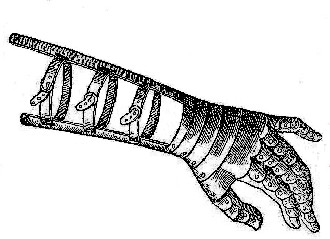 Lower arm - from "Les Oeuvres de M. Ambroise Paré," p. 917 |
With such designs in mind, Dionis gives us a fascinating account of a fully functioning prosthetic arm. "About a year since the Reverend Father Sebastian, a Carmelite-Friar, and one of the Honorary Academicians of the Academy of Sciences, presented an artificial Arm made of Tin, and fill'd with several Springs, by means of which he promised, that being fasten'd to the Stump, the Patient might lead a Horse, Write, and perform the same Functions as with the natural Hand: He assures us that the sole Motion of the Stump set the Springs at work, and would make the Patient move the Fist and Fingers as he pleased. This Machine was not perfected when 'twas presented to the Academy: If it answers his Promises, the maim'd Persons cannot pay him a sufficient Tribute of Praises."9 Indeed!
1 John J. Keevil, Medicine and the Navy 1200-1900: Volume II – 1640-1714, p. 25; 2 Pierre Dionis, A course of chirurgical operations: demonstrated in the royal garden at Paris. 2nd ed., p. 416; 3 Ambroise Paré, The Workes of that Famous Chirurgion Ambrose Parey, p.585; 4 Dionis, p. 416; 5 Ibid.; 6 Paré, p. 588; 7 Dionis, p. 416-7; 8 Paré, p. 585; 9 Dionis, p. 417
Phantom Limbs
"Almost all the Patients who have had an Arm or a Leg cut off, complain of feeling a pain in the Part which they have lost; sometimes they tell us 'tis their great, and other at other times their little Toe, which prevents their Sleeping; and I have met with some Patients who have told me, that those sorts of Pains were more insupportable than those of the Wounds." (Pierre Dionis, A course of chirurgical operations: demonstrated in the royal garden at Paris. 2nd ed., p. 414)
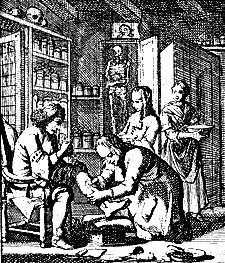
The two French surgical authors Pierre Dionis and Ambroise Paré are also notable because they describe what would later become known as phantom limbs. Paré was the first medical author to describe the phenomon. He explains that patients "for a long while after... will complaine of the part which is cut away.
Verily it is a thing wondrous strange and prodigious, and which will scarse be credited, unless by such as have seene it with their eyes, and heard with their eares the patients who have many monthes after the cutting away of the Legge, grievously complained that they yet felt exceeding great paine of that Leg so cut off."1
Paré goes on to explain that "seeing the case stands so that the Patients imagine they have their members yet entire, and yet doe complaine thereof (which I imagine to come to passe, for that, the cut nerves retire themselves towards their originall, and thereby cause a paine like to convulsions".2 He then suggests "wee must indeavour to give remedy to this symptome. Which may be done by anointing the spine of the backe and all the affected part with... [a] Liniment, which is very powerfull against Convulsions, the Palsie, numnesse, and all cold affects of nervous bodies."3 He then provides another complex recipe for his remedy. He doesn't give us any information on the efficacy of this linament, although the problem still exists today, so, like many period medicines, any ability it had to cure was probably more psychosomatic in nature than actual.
1 Ambroise Paré, The Apologie and Treatise of Ambroise Paré, p. 147; 2 Ibid., p. 153 3 Ibid.

